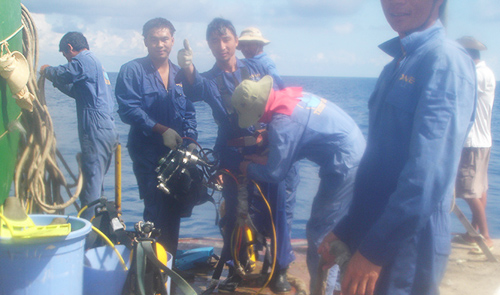More than 20 marine steel-frame platforms have been erected on Vietnam's continental shelf in the East Vietnam Sea since 1989 to aid scientific and service activities off the country's southern coast.
In the open sea, the platforms look like lotus flowers rising from the water. More recently built platforms can sustain a wind level of 14 at a speed of 166kph and waves with an average height of 14m.
Located some 250-350km from the coast, the facilities act as the home of naval soldiers who guard and defend national sovereignty. A platform has a life span of 40 years, double that of previously built facilities.
The first three platforms built on the continental shelf of Vietnam were Phuc Tan and Ba Ke A, both put into use in June 1989, and Tu Chinh A, put into operation a month later.
Preparations for building platforms
“I miss the sea. The sea is immense and very beautiful. Men are tiny compared to the sea,” said Le Huu Viet Duc – general director of Construction Company No.1 and former head of the DK1 marine platform building project 25 years ago.
‘DK1’ refers to ‘Dịch vụ’ (Service) and ‘Kinh tế Kỹ thuật’ (Economy and Technology), meaning it is an economic facility. The digit ‘1’ refers to the first and the farthest layer of platforms from the coast.
Therefore, ‘DK2’ is the second round of platforms built closer to the coast.
The idea to build the marine platforms was initiated by Admiral Giap Van Cuong and approved by the Politburo and the government.
The job of research and construction of the platforms was assigned to different agencies including the Military Academy, the Ministry of Transport, and the High Command of Engineering.
“In short, we were tasked with building homes in the open sea, a job we had never done before,” recalled Duc. “It is the most complicated work we’ve ever completed.”
The job of Duc, who was then 30 years old, was to strengthen a platform so it would not oscillate with the strong wind and waves.
Duc had to borrow two aquatic concrete pumpers from the Tri An hydropower plant in the southern province of Dong Nai.
Without any experience from similar projects to learn, Duc and his staff had to anticipate different situations for preparation before heading to sea.
“I understood that I had no chance to correct my fault in the open sea,” Duc said regarding the preparations more than two decades ago.
Engineer Nguyen Hoai Lam, who is now vice director of Tri Dung construction company and one of 40 staff of the ‘platform project’ 25 years ago, recalled their preparations: “We had to select the best yellow sand and dried it on the yard of Tan Cang Port in Ho Chi Minh City.”
“It was a secret job. So when locals asked us what we were using dry sand for, we said it was for export,” Lam said.
The sand was later mixed with a special kind of concrete to resist corrosion by salt water, he said. After that, the concrete was packed to prepare for building.
During the waiting period, all staff were required to train in swimming during their free time.
Heading to open sea
“We left the mainland for the open sea in March of 1989, soon after Tet [the Lunar New Year festival] when the sea was calm,” Duc said. “My eldest daughter was two years old.”
Forty staff, construction materials, machines, equipment and food were loaded on a 3,000 ton barge, pushed by two towboats which were lent by a salvage unit.
They left Vung Tau Port in the southern region and arrived at the Phuc Tan shoals after two days and two nights.
After the metal posts and the Phuc Tan platform came into shape, Duc was assigned to fortify it against the strong wind and waves.
“Being a leader, I was the first man to jump into the sea,” he added. “After two weeks, our job was almost finished and we were informed of a storm coming.
The 3,000 ton barge, which was considered steady as a rock, began swinging and rocking back and forth when the wind grew stronger.
Some workers were thrown out of the barge and the platform and their clothes were torn in pieces from their bodies by the wind. But rescue staff did their job well, Duc noted.
The two most memorable moments were when a Chinese ship was approaching to observe the job of the Vietnamese group for a whole day.
The other moment was when the job was complete and the working group was divided into two – one leaving for another mission and one remaining on the platform to begin their days at sea.
“We are all men but couldn’t hold back our tears upon departing,” Duc recalled.
In 1990, one of the first platforms failed to resist a strong storm and collapsed. Three soldiers died.
Now, Vietnam has third generation platforms, able to resist winds of 166kph and sea waves at an average height of 14m.
Now, all platforms are equipped with solar energy batteries, windpower electricity systems, and fresh water filtering systems.
The 25th anniversary of the DK1 was held on July 4.
Like us on Facebook or follow us on Twitter to get the latest news about Vietnam!






















































